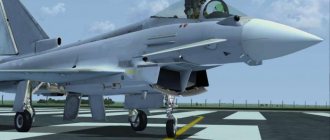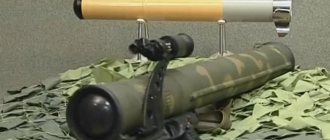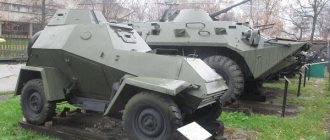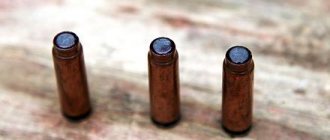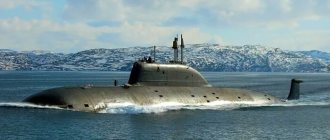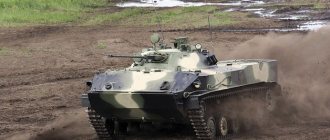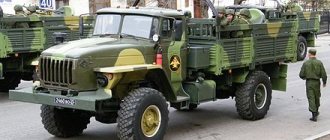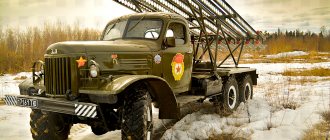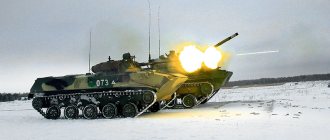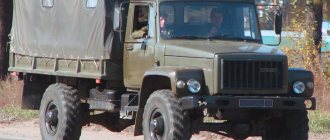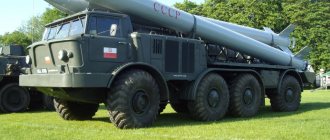Modifications[edit | edit code]
Typhoon K-63968[edit | edit code]
Main article: KAMAZ-63968
Cabover multifunctional modular vehicle. In the modification for transporting personnel, it can transport up to 10 or 16 people. Landing can be carried out either using a ramp or through a door. The front of the cabin has reinforced armor, which provides protection from 30-mm shells; It is possible to install an armor shield covering the windshield. According to other sources, the armor is only designed to withstand 7.62 mm bullets, which corresponds to category 3 according to STANAG. Mine protection corresponds to category 3b. The landing compartment is equipped with triplexes, as well as monitors displaying information from external video cameras. Currently in mass production.
Typhoon K-63969[edit | edit code]
An armored personnel carrier with a 6x6 wheel arrangement and a remote-controlled cannon.[11] Single-volume armored module (cabin and body are a single structure)[12][13]. It was first publicly shown in June 2013 in the workshop during the assembly stage. It has all-round armor designed to withstand 14.5 and 12.7 mm caliber bullets (corresponds to level 4 according to STANAG 4569). Mine protection corresponds to level 3b. The vehicle's curb weight is 19.7 tons, payload is 4 tons. Not mass produced[14].
Typhoon K-53949 “Typhoon 4x4”[edit | edit code]
Typhoon K-53949 at the Victory Parade in 2020.
- Media files on Wikimedia Commons
Multi-purpose all-terrain armored vehicle, army off-road vehicle with a 4x4 wheel arrangement[15]. It has a combined protection made of ceramic armor, with armor steel underneath. The total weight is more than 15 tons, the maximum speed is 105 km/h.
Application: protection and escort of convoys, sanitary transportation, engineering, radiation, chemical and biological reconnaissance, reconnaissance and command post vehicle, fire support vehicle. The car was first presented at the Innovation Day of the Southern Military District in October 2020[16].
Typhoon K-4386 (“Typhoon-VDV”)[edit | edit code]
4-wheeled armored vehicle for the Airborne Forces. Currently undergoing testing.
Ural-63095 "Typhoon-U"[edit | edit code]
Main article: Ural-63095
Inside the armored capsule Ural-63099
Hooded multifunctional modular vehicle (three-seater armored cabin and interchangeable body-armored module)[17].
Ural-63099 "Typhoon-U"[edit | edit code]
A bonneted, single-volume vehicle for transporting personnel. Can carry up to 12 people, landing is carried out through the door.[18][ unauthorized source?
].
Broad cooperation
The creation of the Typhoon family of high-security vehicles began after the adoption in 2010 of the “Concept for the development of military vehicles of the Armed Forces of the Russian Federation for the period until 2020.” Mainly, the document envisaged the decommissioning of obsolete VAT and the creation of unified promising models.
Commenting on the concept on the pages of the Military-Industrial Courier newspaper, the head of the Main Armored Directorate of the Ministry of Defense, Major General Alexander Shevchenko, said that in modern conditions there is a demand for “high-speed vehicles of various payloads and purposes, ensuring the mobility of combat units and rear units.”
- Armored car K-53949 "Typhoon" during special tactical exercises
- © Vitaly Timkiv/RIA Novosti
In his opinion, the new generation VAT should have high cross-country ability “in difficult road conditions”, a smooth ride, stability and controllability at high speeds, and be unnoticeable to enemy technical reconnaissance equipment. Also, as Shevchenko noted, it is necessary to pay attention to the security of the crew.
As part of the development work (R&D) on the Typhoon project, domestic enterprises developed a single unified automobile platform, a new generation diesel engine, an automatic hydromechanical gearbox, controlled suspension, an armored functional module, a frame-panel cabin, combat-resistant tires with adjustable pressure, equipment bulletproof and mine protection, as well as a combat information control system (CIUS).
More than 120 enterprises of the Russian Federation took part in the implementation of the Typhoon design and development project.
A rather complex cooperation chain was built, including the Ural Automobile Plant (Miass), KamAZ (Naberezhnye Chelny), Remdizel CJSC (Naberezhnye Chelny), Steel Research Institute (Moscow), Federal State Unitary Enterprise "Federal Nuclear Center" (Sarov), (Gus-Khrustalny ) and MSTU im. Bauman (Moscow).
The first to be presented to the general public (at the parade on May 9, 2014) was the Typhoon-K (KAMAZ-63968), a universal six-wheeled armored vehicle designed to transport from 10 to 16 military personnel. The weight of the vehicle is 21 tons, the power of the YaMZ-5367 engine is 450 horsepower, the maximum speed is 105 km/h, the cruising range is 1.2 thousand km.
In 2020, a frame car “Typhoon-U” (Ural-63095) weighing 24.5 tons appeared on Red Square. It is capable of transporting up to 16 military personnel or cargo weighing up to 4 tons. The speed of the car on the highway is 100 km/h, the range is 1.4 thousand km. Both Typhoons are equipped with video cameras, night vision devices and remote-controlled weapons.
Now the Ministry of Defense is considering the possibility of installing on the Typhoon-K a remote-controlled combat module (BMDU) Arbalet-DM developed by the Kovrov Electromechanical Plant. The complex allows the vehicle crew to fire from a 12.7-mm 6P49 Kord machine gun in all directions. The target recognition range, depending on terrain conditions, is 1.5–2.5 km.
To date, several hundred Typhoons have been delivered to the troops. Their main operators are units of combined arms reconnaissance, Special Operations Forces, engineering troops and military police. In 2020, KamAZ-63968 and Ural-63095 were deployed to Syria to transport cargo and military personnel. In particular, sappers and military police rode on Typhoons.
In addition to vehicles weighing over 20 tons, the Typhoon family is represented by two four-wheeled vehicles - K-4386 Typhoon-VDV (Wolverine) and KamAZ-53949 Typhoon. The power of the 6-cylinder engine of both models is 350 horsepower. The vehicles can carry up to 10 paratroopers or two tons of cargo.
Iron March: Typhoon armored vehicles for special forces
Combat vehicles with multi-layer armor, a spacious interior and a speed of over a hundred on the highway were once the illusory dream of the Russian military. However, today this dream is coming true - since the end of last year, the Russian army has been operating almost a hundred armored vehicles of the Typhoon family. We will try to figure out why the Russian military will need this equipment.
Combat experience
Wheeled armored vehicles with increased mine protection, which include the Typhoon family, first began to be used in Africa, during the Namibian War of Independence. Later, these vehicles, designated MRAP (from the English Mine Resistant Ambush Protected - resistant to mines and protected from ambush attacks), began to appear in other foreign armies.
For example, the United States began supplying them en masse to supply the coalition group after the invasion of Iraq in 2003. The use of MRAP armored vehicles was determined by the combat situation - after the dispersion of the Iraqi army and the emergence of many disparate gangs, in some cases it became safer to move around Iraqi soil not only under the protection of armor, but also at high speed.
And if well-armed armored personnel carriers could not ensure speed of movement, then the nimble Humvees, not to mention ordinary army trucks, were completely defenseless against mines and heavy machine gun fire.
In our country, the military faced the need for transport similar to MRAP during the second Chechen campaign. After the signing of the Khasavyurt agreements in 1996, the territory of the Chechen Republic turned into a hotbed of banditry and radical Islamism, which just three years later resulted in another confrontation between federal forces and militants. This time, the nature of the fighting moved from direct clashes to the format of guerrilla warfare.
However, the existing vehicles did not meet the conditions for protection from surprise attacks and our military had to invent new equipment “on the knee”.
Since the early 2000s, in television news stories from Chechnya one could see ZIL and Urals cargo trucks covered with armor plates; sometimes armored capsules for several people were installed in the back of trucks on a backing of sandbags. Such “home-made products,” for example, were the “Batyanya” combat vehicle based on the ZIL-131 and the Ural-4320 “Marusya” with a steel box in the back. In 2002, one such Ural was blown up by a landmine, but homemade protection saved the lives of passengers.
ZIL-131
Autoexotics for the army
The Ministry of Defense became concerned about providing the ground forces with armored vehicles with increased security only at the beginning of the second decade of the 21st century. In 2010, the “Concept for the development of military vehicles of the Russian Armed Forces until 2020” was approved, which, among other things, spelled out the need for the development of “highly unified families of armored vehicles.”
The very next year, the first samples were presented to the leadership of the defense department - modular (armored truck with a cab isolated from the body) KAMAZ-63968 and Ural-63095, as well as the single-volume Ural-63099.
If you believe information from open sources, the new Typhoons have a number of advantages compared to the light armored vehicles available in the Armed Forces.
This includes a V-shaped bottom that cuts through the shock wave of a mine explosion, and multiplex glass that can withstand hits from armor-piercing bullets of 14.5 mm caliber, and combined armor protection (“scales” of high-strength ceramic under sheet steel) that can withstand hits from the above ammunition.
Instead of traditional springs, the new vehicles are equipped with a system of hydropneumatic dampers using compressed nitrogen, liquid crystal monitors on the dashboard displace the dial indicator, and in case the armored glass is damaged until visibility is completely lost, the Typhoons are equipped with a video camera system.
In addition, the passenger compartments of the Typhoons are large.
If in an armored personnel carrier (BTR-80) or infantry fighting vehicle a tall fighter in full gear just doesn’t “prop up his ears with his knees,” then in the backs of new armored vehicles a person can stand up.
KAMAZ-63968. PHOTO: VITALY KUZMIN
Where to put it?
So far, all modifications of the family are intended for transporting personnel. The developers claim that modular vehicles, in addition to passenger armored capsules, can carry various types of weapons, and also perform the function of transporting ammunition to cannon artillery positions, and be used for guarding and escorting convoys, sanitary transportation, and conducting engineering and radiation, chemical and biological reconnaissance. The possibility of their use as reconnaissance, command and staff vehicles, and fire support vehicles is being considered.
Another question: which manufacturer - KAMAZ or auto - will ultimately turn out to be the priority supplier of modular three-axle armored vehicles.
For example, KamAZ-63968, made according to the cabover design, has a larger capacity body, it can carry up to 16 people. The driver is provided with multi-point seat belts and an automatic door opening system to the cab.
However, the Typhoons Ural-63095, all other things being equal, have a purely design advantage, which has been confirmed more than once in military conflicts - the hood.
Even in ordinary trucks they were called “one and a half meters of life,” when when hitting a mine, the engine compartment took on the blast wave and fragments, becoming a kind of shield for the driver.
Cabover KAMAZ trucks did not leave a chance for salvation in the event of an explosion in the driver’s cabin.
URAL-63095. PHOTO: VITALY KUZMIN
It is obvious that Typhoons will not occupy the niche of armored personnel carriers - BTR-82A is becoming increasingly widespread in the Armed Forces, and in the future, according to the deputy chairman of the Military-Industrial Commission of the Russian Federation Oleg Bochkarev, serial deliveries of transporters on a unified wheeled platform will begin in 2020. Boomerang".
Now it seems most likely that Typhoons will be supplied to special forces units intended to combat illegal armed groups and sabotage groups.
This is supported by both the speed, mine protection and bulletproof armor described above, and the geography of distribution of this technology.
At the end of 2014, a batch of 30 Typhoons produced by KAMAZ entered the special forces of the Southern Military District; in January of the current year, the special forces of the Southern Military District received twenty more armored vehicles, and in April their number was increased to 80 units. Taking into account the specifics of the regions that are part of the Southern Military District, in particular Crimea and the republics of the North Caucasus, the arrival of new equipment best suited for use in counter-terrorism operations and anti-sabotage combat seems natural.
A “flying” armored car “Typhoon” is being prepared for paratroopers
Russian paratroopers will soon receive a new armored SUV "Typhoon-VDV" - a protected special-purpose vehicle capable of parachute landing.
The product developed at JSC Central Research Institute "Burevestnik" is an analogue of a light wheeled tank and has high firepower. The basis for the creation of the Typhoon-VDV armored vehicle was the KamAZ-53949 (4x4) vehicle of the Typhoon family. A group of students from higher educational institutions of Tatarstan was involved in the development of the first prototype of the Typhoon-VDV, as well as in the assembly of the first prototype. The main task of the designers was to ensure that the vehicle could be dropped from military transport aircraft. An important criterion for the effectiveness of a new product for the Airborne Forces was the level of protection of fighters during off-road transportation.
The public was the first to get acquainted with the unique “flying” armored vehicle for “winged infantry” at the International Military-Technical Forum “Army” in August 2020. Until Typhoon-VDV passes state tests, its exact characteristics are still kept secret, but something is already known. The armored vehicle has high mobility characteristics: a 6-speed automatic transmission and a 350 hp engine. accelerates an 11-ton combat vehicle to 100 km/h. The power reserve will be a record 1200 km. The Typhoon's carrying capacity will be 3 tons. The vehicle will be able to ford a depth of up to 1.9 m, and will be provided with combined ballistic protection of the habitable compartments according to the 3rd level of STANAG 4569. The armored car will also receive a lightly armored engine compartment.
To reduce the weight of the vehicle, the developers were forced to abandon the frame structure: the airborne Typhoon is designed according to the “load-bearing armored hull” design. Due to this solution, the designers managed to increase the carrying capacity of the armored car. In addition, it became possible to install an uninhabited combat module with an automatic 30-mm cannon. Ammunition for the gun of 300 rounds (200 high-explosive fragmentation and 100 armor-piercing tracer ammunition) is isolated from the habitable compartment of the vehicle; the supply of ammunition for the machine gun is 1,200 pieces. The target engagement range is 2 km.
Thanks to a modern combined sight with television and thermal imaging channels and a laser rangefinder, the Typhoon-VDV can perform combat missions even in the dark. The armored car is capable of withstanding explosions of up to six kilograms in TNT equivalent under the wheel and up to four kilograms under the bottom.
Thus, the Typhoon-VDV acts as a universal protected vehicle. This is a “wheeled tank” that has no analogues, capable of providing an unprecedentedly high level of safety when transporting cargo and personnel. In addition, an armored vehicle becomes a dangerous combat unit when combined with various types of weapons.
According to the latest data, the Russian Ministry of Defense has already completed the development of the K4386 Typhoon-VDV protected special purpose vehicle. Now the armored car is awaiting state tests, which will end this year, which in the future will make it possible to launch a full-fledged series with the transfer of equipment to the Airborne Forces. It is planned that the Typhoon-VDV will begin entering service with the Russian army in 2020.
Modifications
Typhoon K-63968
Main article: KAMAZ-63968
Cabover multifunctional modular vehicle. In the modification for transporting personnel, it can transport up to 10 or 16 people. Landing can be carried out either using a ramp or through a door. The front of the cabin has reinforced armor, which provides protection from 30-mm shells; It is possible to install an armor shield covering the windshield. According to other sources, the armor is only designed to withstand 7.62 mm bullets, which corresponds to category 3 according to STANAG. Mine protection corresponds to category 3b. The landing compartment is equipped with triplexes, as well as monitors displaying information from external video cameras. Currently in mass production.
Typhoon K-63969
An armored personnel carrier with a 6x6 wheel arrangement and a remote-controlled cannon.[11] Single-volume armored module (cabin and body are a single structure)[12][13]. It was first publicly shown in June 2013 in the workshop during the assembly stage. It has all-round armor designed to withstand 14.5 and 12.7 mm caliber bullets (corresponds to level 4 according to STANAG 4569). Mine protection corresponds to level 3b. The vehicle's curb weight is 19.7 tons, payload is 4 tons. Not mass produced[14].
Typhoon K-53949 “Typhoon 4x4”
Typhoon K-53949 at the Victory Parade in 2020.
- Media files on Wikimedia Commons
Multi-purpose all-terrain armored vehicle, army off-road vehicle with a 4x4 wheel arrangement[15]. It has a combined protection made of ceramic armor, with armor steel underneath. The total weight is more than 15 tons, the maximum speed is 105 km/h.
Application: protection and escort of convoys, sanitary transportation, engineering, radiation, chemical and biological reconnaissance, reconnaissance and command post vehicle, fire support vehicle. The car was first presented at the Innovation Day of the Southern Military District in October 2020[16].
Typhoon K-4386 (“Typhoon-VDV”)
4-wheeled armored vehicle for the Airborne Forces. Currently undergoing testing.
Ural-63095 "Typhoon-U"
Main article: Ural-63095
Inside the armored capsule Ural-63099
Hooded multifunctional modular vehicle (three-seater armored cabin and interchangeable body-armored module)[17].
Ural-63099 "Typhoon-U"
A bonneted, single-volume vehicle for transporting personnel. Can carry up to 12 people, landing is carried out through the door.[18][ unauthorized source?
].
